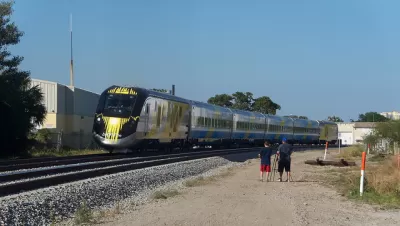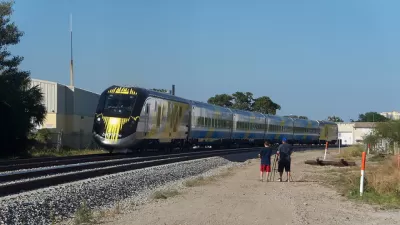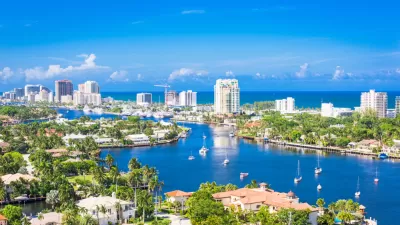A 51-year-old bicyclist became the second fatality in the first week of revenue service. It was the fourth fatality since the summer for the diesel train, which operates from West Palm Beach to Fort Lauderdale.

Both of the recent fatalities, the earlier one being a 32-year-old pedestrian, resulted from attempts to "beat the train" through grade crossings in Boynton Beach, Palm Beach County. Brightline, which began service on Saturday, can travel at speeds up to 125 mph, but the average speed is 80 mph through the current route
"On Wednesday, Jeffrey D. King, 51, was riding his bicycle when he was struck at 4:26 p.m. in the 100 block of the Florida East Coast Railway tracks on Ocean Avenue," said a spokeswoman for the Boynton Beach Police Department spokeswoman, reports Tonya Alanez fir Sun Sentinel on Jan. 17.
Investigators determined he pedaled around the gates, which were down, in an attempt to beat the approaching train.
The circumstances were remarkable similar five days earlier on Friday night, only the mode was different, as the victim was on foot.
"Witnesses told Boynton police it appeared that Melissa Lavell was on the tracks after the gates were in the down position as she tried to make it across before the train approached," reported Alanez and Wayne K. Roustan for the Sentinel on Jan. 13. The Friday night train was the inaugural run carrying business leaders from Fort Lauderdale to West Palm Beach. Revenue service began Saturday, Jan. 14.
A Brightline employee informed the passengers there had been a “trespasser incident” during their two-hour wait on the tracks.
Suicide by train
The term is a familiar one to Caltrain riders on the San Francisco peninsula, which suffered its first fatality of 2018 on Wednesday night in Mountain View after experiencing nine deaths last year. However, the majority of these incidents turn out to be suicides rather than pedestrians and cyclists ducking under crossing gates or motorists stopping on the tracks while stuck in traffic. In fact, Caltrain has installed pedestrian crossing gates alongside the street gates to prevent the type of incidents tragically seen in Boynton Beach this week, although determined people can simple open adjacent pedestrian doors and walk across the tracks, risking a $271 fine.
"Another woman died in July after she was hit in Boca Raton," add Alanez and Roustan. "Her death was investigated as a suicide."
"In November, a second woman was on the tracks in Deerfield Beach [Broward County] when she was struck." While no cause has been assigned, it appeared that it may have been intentional.
A federal issue?
"In the immediate aftermath of Wednesday’s fatality, U.S. Sen. Bill Nelson wrote a letter to U.S. Transportation Secretary Elaine Chao, asking whether enough has been done to boost safety," adds Alanez. He requested "additional information on what actions the Department has taken to address highway-rail grade crossing safety."
[See 2016 post, "Top Priority for Federal Railroad Administration: Reducing Crossing Crashes."]
Nelson might also wish to refer the matter to the Florida Department of Transportation which considered using automated traffic enforcement to ticket motorists who drove around downed SunRail gates at intersections in Orlando in 2015. Whether the cameras would ticket pedestrians and cyclists, though, would need to be addressed.
The company’s trains are expected to reach speeds of up to 79 mph between Miami and West Palm Beach; 110 mph between West Palm Beach and Cocoa Beach [Brevard County]; and 125 mph between Cocoa and Orlando.
FULL STORY: Brightline train kills second person in a week

Planetizen Federal Action Tracker
A weekly monitor of how Trump’s orders and actions are impacting planners and planning in America.

Congressman Proposes Bill to Rename DC Metro “Trump Train”
The Make Autorail Great Again Act would withhold federal funding to the system until the Washington Metropolitan Area Transit Authority (WMATA), rebrands as the Washington Metropolitan Authority for Greater Access (WMAGA).

The Simple Legislative Tool Transforming Vacant Downtowns
In California, Michigan and Georgia, an easy win is bringing dollars — and delight — back to city centers.

The States Losing Rural Delivery Rooms at an Alarming Pace
In some states, as few as 9% of rural hospitals still deliver babies. As a result, rising pre-term births, no adequate pre-term care and "harrowing" close calls are a growing reality.

The Small South Asian Republic Going all in on EVs
Thanks to one simple policy change less than five years ago, 65% of new cars in this Himalayan country are now electric.

DC Backpedals on Bike Lane Protection, Swaps Barriers for Paint
Citing aesthetic concerns, the city is removing the concrete barriers and flexposts that once separated Arizona Avenue cyclists from motor vehicles.
Urban Design for Planners 1: Software Tools
This six-course series explores essential urban design concepts using open source software and equips planners with the tools they need to participate fully in the urban design process.
Planning for Universal Design
Learn the tools for implementing Universal Design in planning regulations.
Smith Gee Studio
City of Charlotte
City of Camden Redevelopment Agency
City of Astoria
Transportation Research & Education Center (TREC) at Portland State University
US High Speed Rail Association
City of Camden Redevelopment Agency
Municipality of Princeton (NJ)




























